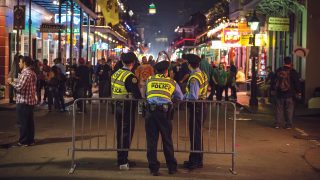
PTSD is the quintessential mind–body–spirit disorder given its disruption of multiple body systems, disabling symptoms and high rates of chronic illnesses and autoimmune disorders. An innovation in PTSD treatment is the application of integrative medicine. This application supports a whole-body approach utilizing multiple fields of medicine and nutritional sciences in addition to the various empirically validated conventional treatment approaches. An integrative treatment protocol for PTSD would include assessment, digestion, culinary medicine, nutritional therapies, herbs, detoxification, exercise and movement, and somatics. The importance of rituals and connection is also critical to healing the whole person.
Assessment. Step #1 is to identify the stage in which the patient presents — self-care, process or wounded healer.
In the self-care stage, the officer is challenged with self-care behaviors and therefore needs to focus on them. Are they looking after their own health? Are they sleeping, eating, resting and grooming? Are they self-medicating (e.g., alcohol, pills, porn, affairs, gambling, food, caffeine)? Are they self-harming (meaning, are they hurting themselves on purpose)? Are they wearing their vest in the field? Are they driving buckled up? Are they charging into the search area without following the proper tactics? Are they a walking zombie?
Once the officer is practicing self-care, process work may begin. This is the work of making sense of the trauma and one’s response to the trauma. This may require reflection, self-compassion, sifting through the images, sensations and feelings, monitoring and replacing negative irrational thoughts with more positive rational ones, pacing oneself and utilizing skills to cultivate lower emotional arousal (e.g., emotion regulation skills, distress tolerance skills, mindfulness skills, interpersonal effectiveness skills).
The officer who ultimately transcends and transmutes the traumatic events may become a healer for themselves and possibly others. The wounded healer is actually an archetype conceptualized by the famous psychiatrist Carl Jung — Freud’s top disciple — when he suggested that sometimes disease is the best training for a physician. And we already know this to be true. Research has proven that Alcoholics Anonymous (AA) is the run-away most effective treatment for alcoholism, and in AA it is precisely the diseased OG alcoholic (aka AA sponsor) who guides and supports the more novitiate diseased alcoholic. Consider Peace Officer’s Fellowship (POF) meetings (which are AA meetings for cops) where alcoholic cops working their sobriety program are the sponsors and supporters helping other alcoholic cops get and stay sober.
The officer who ultimately transcends and transmutes the traumatic events may become a healer for themselves and possibly others.
Digestion. Digestive strategies can be utilized to decrease dissociation often present in PTSD. Enhance mindful eating. Transform self-medication behaviors. Ease the digestive process. Oftentimes, PTSD patients have a tough time with digestion. They tend to do better with broths, very simple foods, cooked foods, porridges and legumes that they can digest well. Smoothies are helpful because nutrient formulas can be added in powder form (e.g., protein powder) or liquid form (e.g., liquid multivitamins, omega-3 for the brain). Keep it simple for the sake of digestion.
Culinary medicine. Officers with chronic stress need protein. Consider focusing on protein broths (e.g., bone broth, chicken broth, collagen broth) for easy digestion and absorption of nutrients. Consider adding anti-inflammatory spices. Turmeric, ginger and cinnamon are the main ingredients in golden milk, and they have strong anti-inflammatory properties.
Nutritional therapies. Officers with PTSD may want to consider the nutritional therapies for chronic stress, such as glandulars (e.g., liver, brain, hypothalamus), B-complex and taurine. Research also shows that taurine supplementation lowers blood pressure and improves vascular function in pre-hypertension.
Herbs. Herb categories to consider include natural anxiolytics (used to reduce anxiety), adaptogens (plants to help your body respond to stress, anxiety and fatigue) and aromatherapy (essential oils for therapeutic benefit).
Drugs used to treat anxiety have many negative side effects, including addiction, depression, suicide, seizures, sexual dysfunction, headaches and more. Anxiolytic medications do not restore normal levels of neurotransmitters but instead manipulate the brain chemistry.
Natural anxiolytics, however, have been known since ancient times. For example, St. Hildegard von Bingen (b. 1098) sprinkled lavender on bed pillowcases to ease insomnia, nightmares and other sleep dysfunctions.
Adaptogens support the capacity to adapt to stress (restoring the capacity to cope and respond). They act like low-level molecular weight vaccines on the stress system. These plants and active extracts support adrenal function. They help calm. Hippocrates (b. 460 B.C.) himself prescribed valerian root, for example, for patient insomnia.
Citrus-based aromatherapy can be a mood booster, and the practice of using essential oils to enhance mood is thought to originate in ancient Chinese medicine (although the ancient Mesopotamians 5,000 years ago extracted oils from different plants for healing). Think about the smell of cinnamon at Christmas. Broil some cinnamon bark. Cut open a lemon or a lime. How about an Italian blood-red orange? Get some essential oils. Be surrounded by wonderful smells that lift the mood and decrease stress.
Detoxification. Some patients decrease dissociation with skin brushing, which is also a psychological grounding or mindfulness strategy. Full-body cryotherapy (or even if you just hold an ice pack in each hand, or take a two-minute ice-cold shower or jump in the ocean and stand there) increases distress tolerance and mindfulness while also reducing inflammation and pain. Hyperbaric oxygen therapy (HBOT), which has been used by NASA astronauts, Russian cosmonauts, professional athletes, scuba divers and others, delivers a higher concentration of oxygen to the lungs for healing and recovery.
Exercise and movement. If an officer is in the early stage of PTSD (think: self-care), consider vigorous cardio exercise for a minimum of 60 minutes per day. This may help slow the mind and reset the nervous system. Consider it part of one’s daily medicine.
Consider incorporating yoga and meditation in the middle and later stages of PTSD. These strategies are more silent and inward focusing and, as such, would likely not be tolerated in the initial stages of PTSD.
Somatics. Officers tend to respond very well to bodywork (e.g., massage sessions, pro stretch sessions) and body-oriented
psychotherapies (e.g., breathwork, progressive muscle relaxation, biofeedback). If touch played a role in the trauma (e.g., sexual assault), then bodywork may not be optimal for that individual.
Rituals and connection. Rituals (e.g., lighting a votive candle,
receiving Holy Communion, praying the rosary, receiving the sacrament of anointing of the sick, receiving the sacrament of reconciliation) may be instrumental in the individual officer’s healing as well as their ability to create meaning and purpose in their life after the trauma. However, group rituals (e.g., first responder retreats, Thursday night dinners with the boys, praying together, Baker to Vegas training runs, National Police Week) are equally, if not more, important in healing (e.g., emotion regulation, social support), especially for cops. Group rituals aid healing, so help cops connect with their tribe. Consider POF meetings. Consider Save A Warrior. Consider support groups.
One size does not fit all. The central clinical challenge is to identify methods that are isomorphic to each individual and optimal for their respective stage of recovery. Officers are therefore strongly encouraged to work collaboratively with their health team to identify the right strategies for them.
As seen in the September 2022 issue of American Police Beat magazine.
Don’t miss out on another issue today! Click below:





